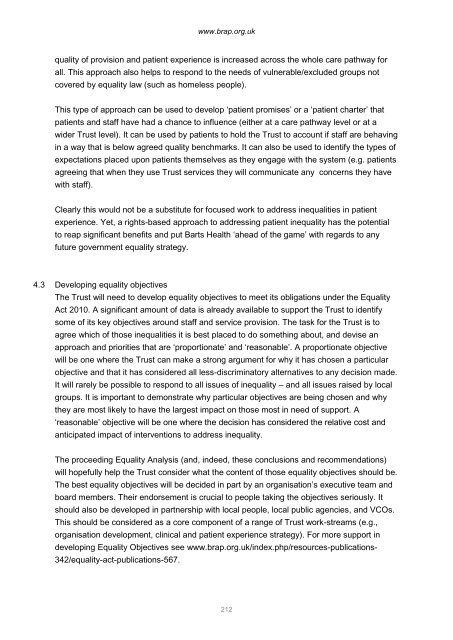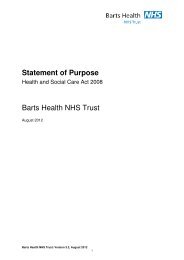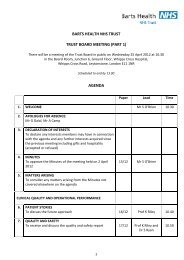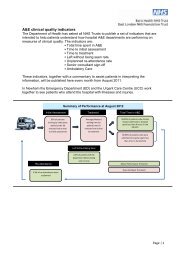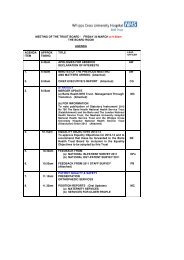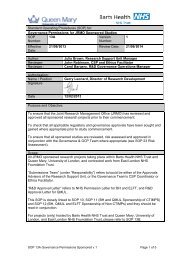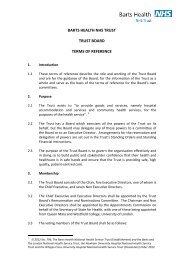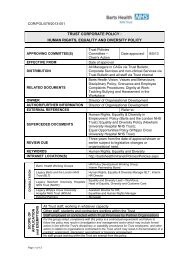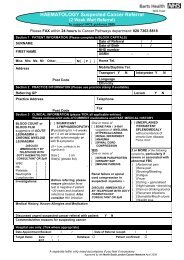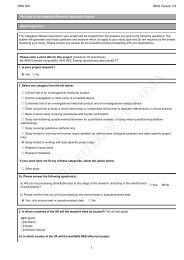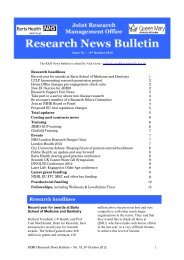Barts Health Equality and Human Rights Impact Assessment Report
Barts Health Equality and Human Rights Impact Assessment Report
Barts Health Equality and Human Rights Impact Assessment Report
- No tags were found...
You also want an ePaper? Increase the reach of your titles
YUMPU automatically turns print PDFs into web optimized ePapers that Google loves.
www.brap.org.ukquality of provision <strong>and</strong> patient experience is increased across the whole care pathway forall. This approach also helps to respond to the needs of vulnerable/excluded groups notcovered by equality law (such as homeless people).This type of approach can be used to develop ‘patient promises’ or a ‘patient charter’ thatpatients <strong>and</strong> staff have had a chance to influence (either at a care pathway level or at awider Trust level). It can be used by patients to hold the Trust to account if staff are behavingin a way that is below agreed quality benchmarks. It can also be used to identify the types ofexpectations placed upon patients themselves as they engage with the system (e.g. patientsagreeing that when they use Trust services they will communicate any concerns they havewith staff).Clearly this would not be a substitute for focused work to address inequalities in patientexperience. Yet, a rights-based approach to addressing patient inequality has the potentialto reap significant benefits <strong>and</strong> put <strong>Barts</strong> <strong>Health</strong> ‘ahead of the game’ with regards to anyfuture government equality strategy.4.3 Developing equality objectivesThe Trust will need to develop equality objectives to meet its obligations under the <strong>Equality</strong>Act 2010. A significant amount of data is already available to support the Trust to identifysome of its key objectives around staff <strong>and</strong> service provision. The task for the Trust is toagree which of those inequalities it is best placed to do something about, <strong>and</strong> devise anapproach <strong>and</strong> priorities that are ‘proportionate’ <strong>and</strong> ‘reasonable’. A proportionate objectivewill be one where the Trust can make a strong argument for why it has chosen a particularobjective <strong>and</strong> that it has considered all less-discriminatory alternatives to any decision made.It will rarely be possible to respond to all issues of inequality – <strong>and</strong> all issues raised by localgroups. It is important to demonstrate why particular objectives are being chosen <strong>and</strong> whythey are most likely to have the largest impact on those most in need of support. A‘reasonable’ objective will be one where the decision has considered the relative cost <strong>and</strong>anticipated impact of interventions to address inequality.The proceeding <strong>Equality</strong> Analysis (<strong>and</strong>, indeed, these conclusions <strong>and</strong> recommendations)will hopefully help the Trust consider what the content of those equality objectives should be.The best equality objectives will be decided in part by an organisation’s executive team <strong>and</strong>board members. Their endorsement is crucial to people taking the objectives seriously. Itshould also be developed in partnership with local people, local public agencies, <strong>and</strong> VCOs.This should be considered as a core component of a range of Trust work-streams (e.g.,organisation development, clinical <strong>and</strong> patient experience strategy). For more support indeveloping <strong>Equality</strong> Objectives see www.brap.org.uk/index.php/resources-publications-342/equality-act-publications-567.212


